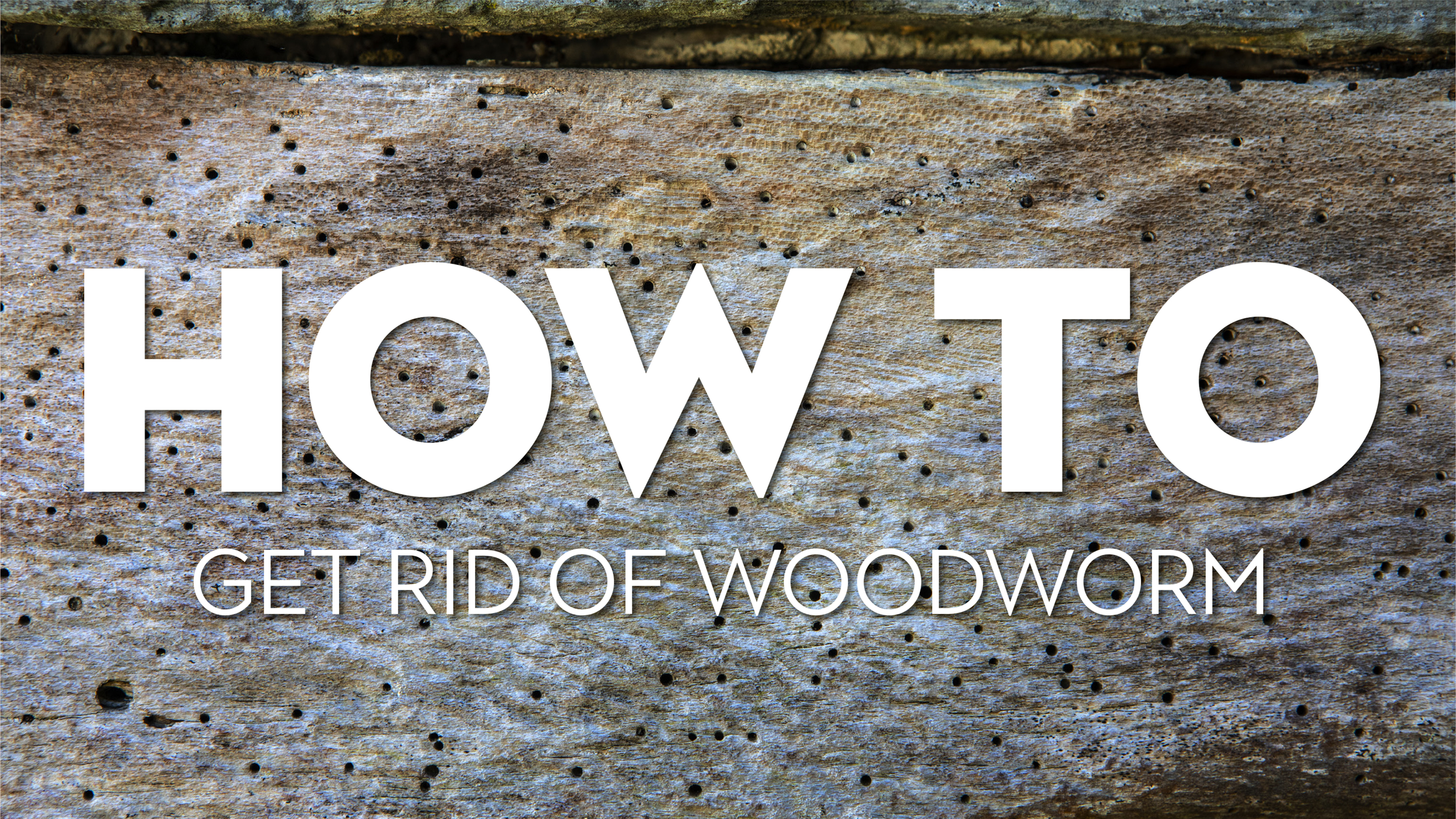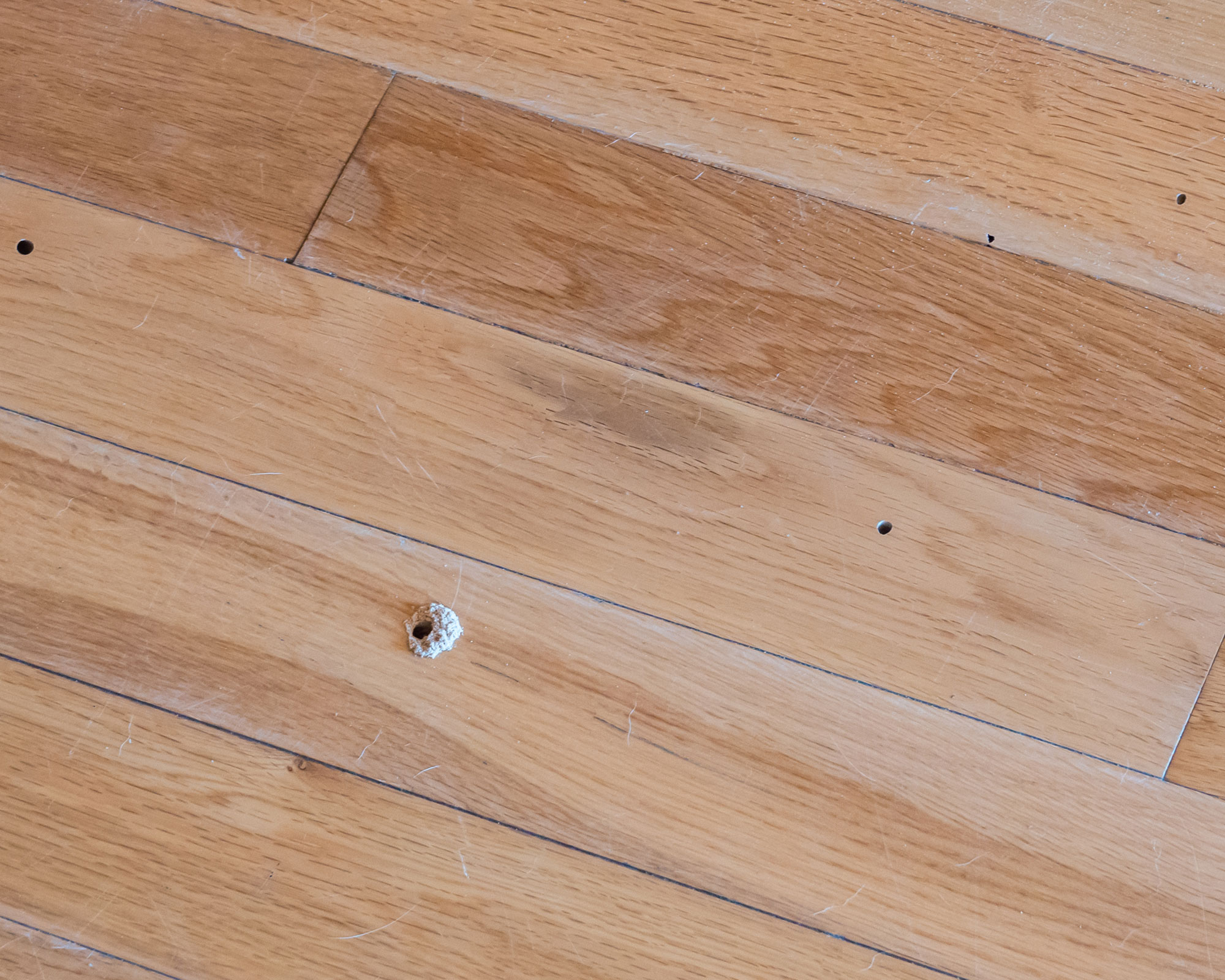How to get rid of woodworm, and identify an infestation
Find out how to get rid of woodworm – and fast, before it spreads and ruins your hardwood flooring and furniture
Christina Chrysostomou

At your wits' end wondering how to get rid of woodworm? Never fear – we've got the answer. Woodworm – not actually worms at all, by the way – are the wood-eating larvae of lots of different species of beetle, usually the Common Furniture Beetle (Anobium punctatum). However, there are more scary-sounding types including the Deathwatch (Xestobium rufovillosum), House Longhorn (Hylotrupes bajulus), and Powder Post (Lyctus brunneus) beetle – gah!
These larvae bore small round holes in furniture, such as coffee tables, beams, and wooden flooring as they exit the timber, leaving behind a powdery residue. The woodworm will happily spread from one piece of wood to another, ultimately causing damage – and in some cases, serious structural problems.
Not sure if this the pest you're dealing with? Check out our how to identify bugs to find out which unwanted guest has invaded your home. It can also be helpful to look out for bore dust, or frass, caused by emerging beetles. They instinctively head towards the light, so you might spot them around loft hatches or near windows.
Experts at The British Pest Control Association explain more: 'Woodworm is frequently introduced into the house in second-hand furniture, tea chests or wicker-work; but the beetles are quite capable of flying in through a window from nearby dead branches of trees. They may then attack floorboards, joinery and, more seriously, structural timbers such as rafters and joists.'
For this reason, it's vital you know how to get rid of woodworms as soon as you spot the signs.
Where does woodworm come from?
Woodworm may have come into a house on a piece of old furniture, or infested timber. Bear this in mind when antique shopping – if there are fresh signs of woodworm in a piece – give it a wide berth.
The adult beetles lay eggs on, or just under the surface of, a piece of wood; the larvae then feed on it before pupating and hatching. The cycle is then repeated.
Get small space home decor ideas, celeb inspiration, DIY tips and more, straight to your inbox!

The larvae like their timber habitat to have a higher moisture content than is typical, so it's likely, if you discover a woodworm problem in your home, that there is also a problem with excess damp, whether in a poorly-ventilated roof or damp cellar. However, damp conditions are not a must.
Outside of the home, woodworm can eat away at outdoor furniture and fixtures, so where possible try and keep your deck dry, and stow wooden garden furniture away or keep it protected with a waterproof cover after use.
'Using plastic to cover the furniture or affected pieces and spraying insecticide through a small hole effectively eliminates woodworm. This technique is incredibly effective despite its simplicity.' says Jordan Foster, pest expert, Fantastic Pest Control.
And, if you haven't made a decision on your external flooring just yet, consider a non-wood type. We've got a guide on which composite decking is best if you're unsure.
What are the signs of woodworm?
The first step is to look out for the common signs of woodworm. The British Pest Control Association describes some telltale signs to look out for: 'The first sign of woodworm is the appearance of neat round holes, 2mm across, in wooden surfaces, often accompanied by tiny piles of wood dust beneath them. Fresh holes show clean white wood inside. Emerging adult beetles make the holes. Immature grubs may still be tunnelling away inside the wood.'

Spotting the signs of woodworm:
- New exit holes: look out for these in furniture, beams and flooring; they're particularly likely to appear from May to October when woodworm are active. Don't believe anyone who tells you that the holes are a sign that the woodworm have left. In fact, it's entirely possible that new larvae will be within the wood.
- Dust around the holes: this might be the first thing you notice. It's not actually dust; nope, this powdery residue we mentioned earlier is droppings, and just looks like fine sawdust.
- Weak floorboards or beams: this is a sign of a serious woodworm infestation.
- Larvae: they're creamy white in color and look like little grubs, but are smaller than the tip of a pencil, so difficult to spot.
- Beetles: dead or alive; they are around 3mm long and brownish/black.
How to treat a woodworm infestation
If you suspect a woodworm infestation, it's always worth asking a trusted professional before attempting a DIY treatment. Why? Well, while all woodworm signs might look the same to the untrained eye, different types of beetle like to munch on different types of wood. Some, for example, will target loft beams, others like hardwoods; this means some will cause structural damage, while others might just ruin your favorite family heirloom...
For example, Jamie Penny, owner, and operator of MyHomeDwelling says: 'Infestations of the Death Watch beetle take place deep within the wood, thus both an injectable treatment and a surface treatment are crucial. To do this, a woodworm treatment spray can be injected into the adult beetle escape holes,'
'Alternately, the wood can be treated by drilling into the danger zone and injecting a paste or gel woodworm treatment into the wood. Before beginning any treatment, it is advisable to get professional advice because the Death Watch beetle's larvae frequently cause more damage than the Common Furniture bug. Always seek expert advice if you think you may have a House Longhorn woodworm infestation.'
'All of the building's wood will need to be treated and examined for structural soundness. It might be OK to proceed and treat the timber using the same treatments and procedures you would use to treat Death Watch beetles if there is no major structural damage and the infestation is modest. However, you need to use this kind of woodworm with extreme caution.'
However, there are lots of DIY products readily available to treat infested furniture, including woodworm killer solutions that are suitable for use on tables and chairs.
In the case of a severe infestation, or particularly delicate antique furniture, advanced technologies can help, such as Controlled Atmosphere Technology (CAT), which involves using inert gases in a controlled atmosphere to eliminate all life stages of the insects, including eggs and larvae, while leaving no harmful residues.
When repairing antique furniture that has suffered woodworm damage, it is best to seek advice from restoration specialists. Once yours is sorted, find out how to clean and polish wood furniture in our in-depth guide.
How to get rid of woodworm yourself
Want to know how to get rid of woodworm yourself? If you are confident that the woodworm infestation is small and limited, perhaps to a piece of furniture, you can try treating it with a good quality, low odor boron-based liquid pesticide, following the instructions to the letter and keeping the treatment well away from pets and kids.
According to Borates Today: 'Borates repel wood-eating insects by messing up their digestive system, eventually leading to their death. Certain borate formulations may also stop corrosion in wood, while other formulations and applications act as a fire retardant.' Using this logic, it can be an effective solution to getting rid of termites too!
Another option is to put out sticky fly traps in poorly-ventilated rooms; these may catch some of the emerging beetles, but it's a long shot.
It's worth knowing that there's no guarantee that DIY methods will work because these types of treatment do not penetrate much past the surface of the wood. They might kill adult beetles as they emerge but won't reach any larvae inside. And if they don't emerge immediately, they won't be affected by the insecticide you've used – and only repeated treatments will ensure they are. However, if you're on the hunt for an insect killer that will assassinate woodworm, try searching for a solution that contains Permethrin as this is meant to be lethal to the pest in question, paralyzing them in the process.
However, it is toxic, so once the water-based product is applied to your furniture, you should keep it out of reach of pets and young children, and wait until it has dried completely. Since you'll be working with a toxic chemical, you'll need a gas mask.
Foster says: 'Most of the Permethrin-based products you'll find on the market today come in large tubes and are highly concentrated,'
'You'll need to dilute some with water. Before you use it, read the label. There are products for specific woodworms, and others are universal. Before applying the product, you should remove any finish or paint. You can sand the infested section of your furniture with some sandpaper. Then apply the solution to the damaged area –anything living inside will die. The damaged wood needs to be recoated.'
'Alternatively, you could mix sawdust and wood glue in a cup until you get a paste. Using a damp cloth, wipe away the mixture after smearing it into the holes. Wait for it to dry. You should treat the rest of your wooden furniture with the same solution, even if the woodworm is gone. You want to ensure it doesn't find its way to a new nest, so pre-treat your remaining possessions.'
Natural ways to get rid of woodworm
Cleaning with vinegar: you can use vinegar to encourage woodworms to vacate. It won't kill them, but it will make the environment super unpleasant, and force them to leave. All you need to do is mix equal parts of vinegar and water in a spray bottle and apply it to the affected area. Don't be surprised if you see them scurrying out. You can then decide their fate once they've forfeited their squatter's rights.
Acorns: The scent of fresh acorns attracts these bugs so that you can wrap a few in a cloth. As the breeding season starts, adults lay their eggs on the cloth, and the larvae eat the acorns. You can throw away the cloth and its unpleasant occupants after the warm season (when the woodworm reproduces). It's a slow method, but it's an effective complement to other treatments and can even be used to prevent woodworms.' says Foster. If you haven't got a forest nearby, you can buy real acorns from Amazon (when in season) or Etsy.
Beeswax: 'You can melt beeswax and tint it to match the wood, enough to fill the holes. Woodworms hate beeswax, so this method is sure to work. But it's not a long-term solution. Another option is to use 'wood putty' to cover the damage.' adds Foster.
Diatomaceous earth: 'This is a naturally occurring substance that is made up of the fossilized remains of tiny aquatic creatures called diatoms. It works by absorbing lipids from the exoskeletons of insects, which causes them to dehydrate and die.' says Martin Seeley, CEO, and founder of Mattress Next Day. Find out where to buy diatomaceous earth, and what else you can use it for in our guide.
On the contrary, Rentokil stipulates that it depends where you see the signs: 'If you have spotted signs of woodworm in structural timber such as rafters, beams or large areas such as floorboards, skirting or stairs, then DIY products are not recommended.'
Using professionals to get rid of woodworm
If your woodworm infestation is widespread, prolonged or in the structural parts of your property, a thorough chemical treatment by a professional is your best option.
It's important to ensure the company you appoint to do the work is qualified. Check they have the correct certifications in place, that they are members of an industry association, such as Property Care Association, and that they are insured for the work they will be doing.
Recommendations from friends and family are important, but if you can't get any, you could check online reviews to see how other customers have found them. No online reviews? Ask the company if they can put you in touch with former customers, so that you can find out more.
Finally, as with any work, get more than one quote in writing, and ensure the quote is a quote and not an estimate. Get in writing what will be involved, and how long the work will take, too. The company's response to all these requests will help demonstrate their professionalism, too.
What to do if woodworm has infested structural beams and floors
If the timbers in your home have been structurally compromised – you'll know this if the wood crumbles or breaks when you touch it – it's worth getting professional advice about whether it will be more cost-effective to cut away and replace the damaged parts, or better to remove and replace them in their entirety.
Bear in mind that a woodworm infestation doesn't necessarily mean that timbers will be structurally affected, since woodworm usually only infect the upper layer of wood. Caught early, you may find that the repairs are not as drastic as you might first have feared. Find out more about maintaining old timber frame buildings, to ensure your home stays in tip-top condition.
Dealing with the financial impact of woodworm
If you're familiar with renting, it's courtesy to let your landlord know that you suspect there is a woodworm infestation, taking pictures of the affected furniture if necessary as evidence of the woodworm damage. He or she should have the appropriate home insurance which covers any particularly expensive items such as sofas, dining tables and bed frames.
If you've brought your own furnishings into your leased property, or you're a homeowner, you shouldn't assume that conventional contents insurance will cover damage from pests.
Matt Ayres, copywriter at Admiral says: 'Damage caused by woodworm is rarely covered by home insurance. At Admiral it’s listed under the general exceptions section of our home insurance policies, along with other gradual and preventable problems such as rust, corrosion, insects and vermin.'
'Home insurance is intended to protect you against more serious and unpredictable threats such as floods, fires and theft. Woodworm, on the other hand, is generally easy to deal with.'
Pest control companies, like Rentokil can carry out a survey and provide a specific policy if wood-boring insect or fungi damage is something that concerns you.
Use our guide to find out how to repair wooden floors including those riddled with woodworm.
Preventing woodworm infestations
As with any infestation, preventing woodworm is better than treating it. Removing humidity by ensuring rooms are properly heated and ventilated will make your home less attractive to woodworm, as they need a certain about humidity to breed.
If you are worried about the damp in structural timbers and floorboards, you can test its humidity with a timber moisture meter (which you can buy on Amazon). Any moisture content reading over 20 per cent will need dealing with.
If you can pinpoint the woodworm to any newly-bought, single piece of furniture or have spotted an early, isolated infestation, getting rid of the affected piece(s) could prevent, or at least minimize, any further woodworm invasions in the rest of the house.
Be sure to destroy or dispose of these items responsibly. If your state or council can't get rid of it for you, you might be wondering if you can have a bonfire in the backyard (and cremate the creepy crawlies in the process). For the most part, this is legal in the UK, but you should pay due diligence to whether you can burn certain furnishings before throwing them into the fire.
How do you stop woodworm from spreading?
'A homeowner can do a few things to address woodworm infestations. The biggest is to lower the moisture content in the wood. This includes providing air circulation, vents, and moisture barriers under a home. Dehumidifiers may also be needed. This is a slow process and can take time for the wood to dry out depending on the conditions,' says Steven Dupuy, associate certified entomologist, Ehrlich Pest Control.
In some cases, the furniture may need to be fumigated. If that's the case, it's always best to have a licensed pest control operator handle that for you. Prevention is always the best treatment here. Keep the humidity and moisture levels down.

Among his current responsibilities, Jordan Foster is mainly responsible for writing content related to pest control requests.
'It's been ten years since I started with Fantastic Pest Control. I started as a pest control technician. As such, I treated a lot of different pests in private households. To keep up with the ever-changing field of pest control, I invested a lot of time in progressive training,' he explains.
'But I've set myself the goal of never letting go of communication with the people fighting pests. Now and then, I catch up with the pest control technicians or attend to a few jobs they do. I need to be updated on pest control methods, behaviour, etc. Pest control isn't easy, but knowledge can be a huge help.'

Lucy is Global Editor-in-Chief of Homes & Gardens having worked on numerous interiors and property titles. She was founding Editor of Channel 4’s 4Homes magazine, was Associate Editor at Ideal Home, before becoming Editor-in-Chief of Realhomes.com in 2018 then moving to Homes & Gardens in 2021. She has also written for Huffington Post, AOL, UKTV, MSN, House Beautiful, Good Homes, and many women’s titles. Find her writing about everything from buying and selling property, self build, DIY, design and consumer issues to gardening.
- Christina ChrysostomouFormer acting head ecommerce editor


